Key takeaways:
- Local support networks foster community resilience by building trust and facilitating connections among individuals, especially those facing hardships.
- Homeless charities not only provide immediate assistance but also create long-term empowerment through skill-building and community partnerships.
- Sharing personal stories within the community can create empathy and strengthen relationships, driving collective support and change.
- Continuous engagement and collaboration with local organizations are crucial for sustaining and growing support networks, ensuring they adapt to community needs.

Understanding local support networks
Local support networks are the lifeblood of community resilience. I remember the first time I attended a neighborhood meeting; I was struck by the diversity of individuals who came together to share not just resources, but also stories. It made me realize how vital these networks are for building trust and fostering connections among people who might otherwise feel isolated.
Think about it: when someone is experiencing hardship, they often need more than just material help; they crave understanding and companionship. I’ve seen how a simple coffee meet-up can transform an uninformed bystander into an informed ally, capable of advocating for change. It’s astonishing how these interactions build not only support but also foster a sense of belonging.
What often surprises me is how organically these networks can form. In one instance, I facilitated a small gathering for locals to share ideas on tackling homelessness in our area. It was invigorating to watch participants discover each other’s strengths and passions, ultimately leading to coordinated efforts that are both impactful and sustainable. This sense of shared purpose illustrates the profound change that can arise when communities unite, creating enduring bonds that benefit everyone involved.
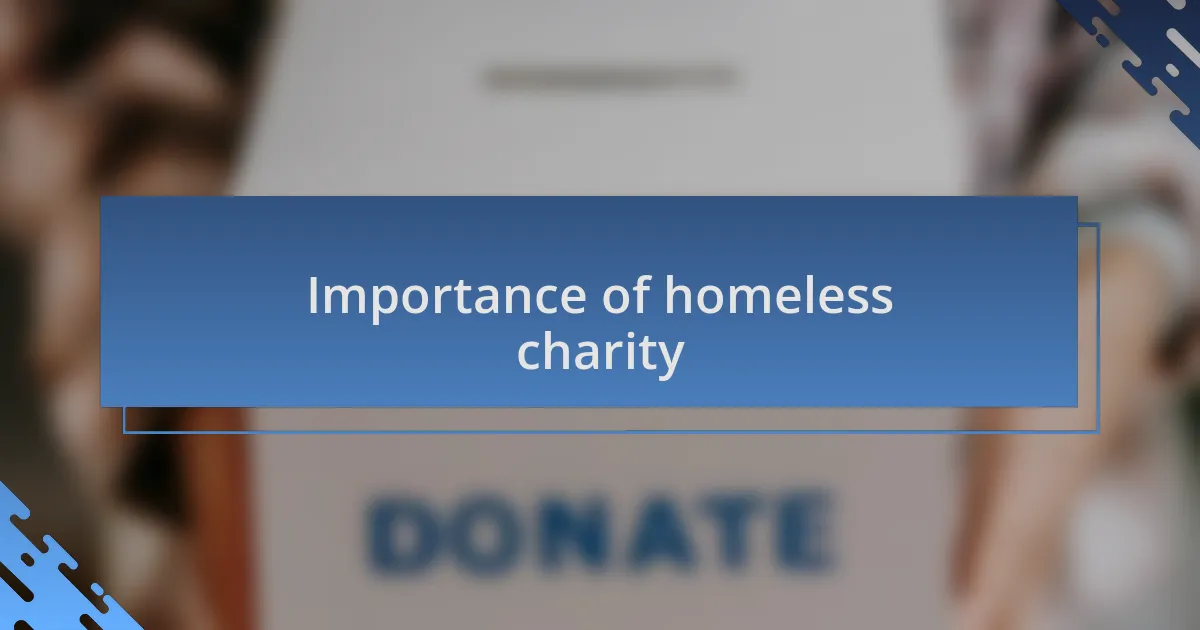
Importance of homeless charity
Homeless charity plays a crucial role in addressing immediate needs while also laying the groundwork for long-term solutions. I once volunteered at a shelter where I witnessed the power of basic services—free meals and warm clothes. These provisions are not just about charity; they provide individuals with the dignity and respect everyone deserves. Can you imagine facing the world without even a warm meal?
What truly struck me was the ripple effect of charitable efforts within the community. For instance, when a local charity organized job training sessions, participants not only gained new skills but also built connections with employers. This was a lightbulb moment for me, highlighting how charity can be a catalyst for empowerment, not just a stopgap measure. It made me reflect: when we invest in people rather than merely providing for their needs, we reshape futures.
Moreover, I’ve seen firsthand how homeless charities forge partnerships that extend beyond immediate assistance. One time, a community event brought different organizations together, from mental health services to housing authorities. Witnessing these collaborations made me realize the importance of a multifaceted approach in tackling homelessness. It reminded me that effective charity is not isolated; it’s a network of care interwoven into the fabric of society itself.
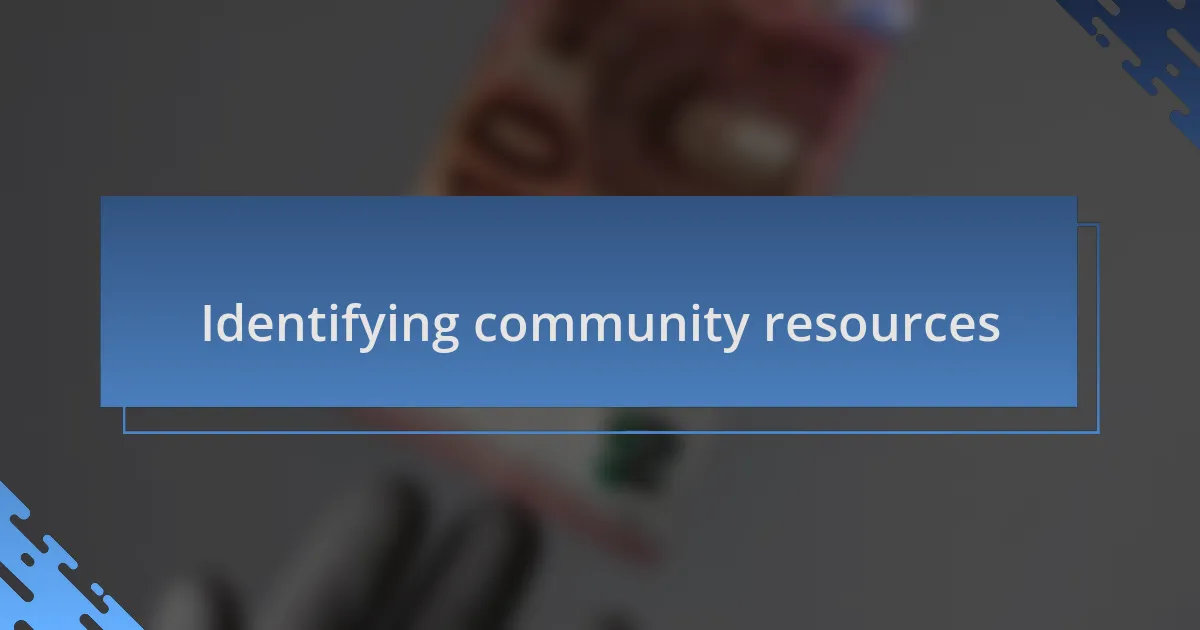
Identifying community resources
Identifying community resources begins with understanding what’s already available. During my time volunteering, I was amazed to discover local food banks, shelters, and health clinics that many people weren’t even aware of. How often do we overlook these resources because we assume they aren’t there? I learned that a simple directory or list could empower those in need to access services that could significantly improve their circumstances.
As I explored different neighborhoods, I found that community centers often serve as a hub for multiple resources. I remember one center in particular where various workshops—everything from budgeting skills to resume writing—were offered. It was heartwarming to see people not just seeking help but actively participating in their own growth. Have you ever considered how just one place can create such a strong sense of belonging?
I also realized that connecting with local businesses can uncover even more support options. I was surprised when a small café I frequented turned out to regularly donate leftover food to shelters. This model not only helps reduce waste but also fosters a sense of community responsibility. Isn’t it uplifting to think that everyday interactions can lead to collaborations that uplift our neighbors?
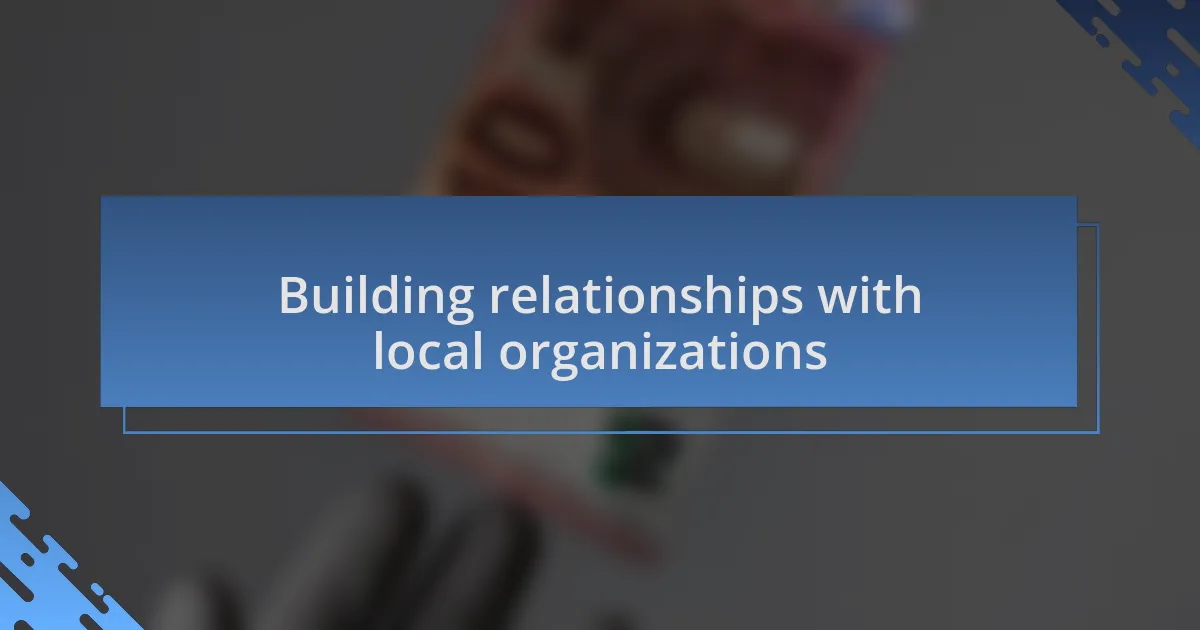
Building relationships with local organizations
One of the most rewarding experiences I had was reaching out to local organizations that were already making a difference. I remember my first meeting with a nearby non-profit focused on job training; their passion was contagious, and it made me realize how vital these connections are. Have you ever felt that spark when you meet people who share your vision? It’s incredible how these initial contacts can blossom into collaborative efforts that benefit the entire community.
Establishing trust with local organizations is essential. I recall a moment when a local health clinic invited us to discuss the needs of their clients. Their openness made the conversation flow effortlessly, allowing us to pinpoint areas where we could collaborate more effectively. It’s in these candid discussions that real relationships form, don’t you think? When organizations work together, not only are resources better utilized, but the overall impact becomes much greater.
I’ve also found that attending local events can be a game-changer for building these relationships. At a recent community fair, I struck up a conversation with a leader from a youth outreach program, discovering shared goals and complementary services. There’s something special about face-to-face interactions; they can establish a foundation of trust and camaraderie that emails just can’t achieve. How often do we get caught up in our methods, forgetting the power of human connection?
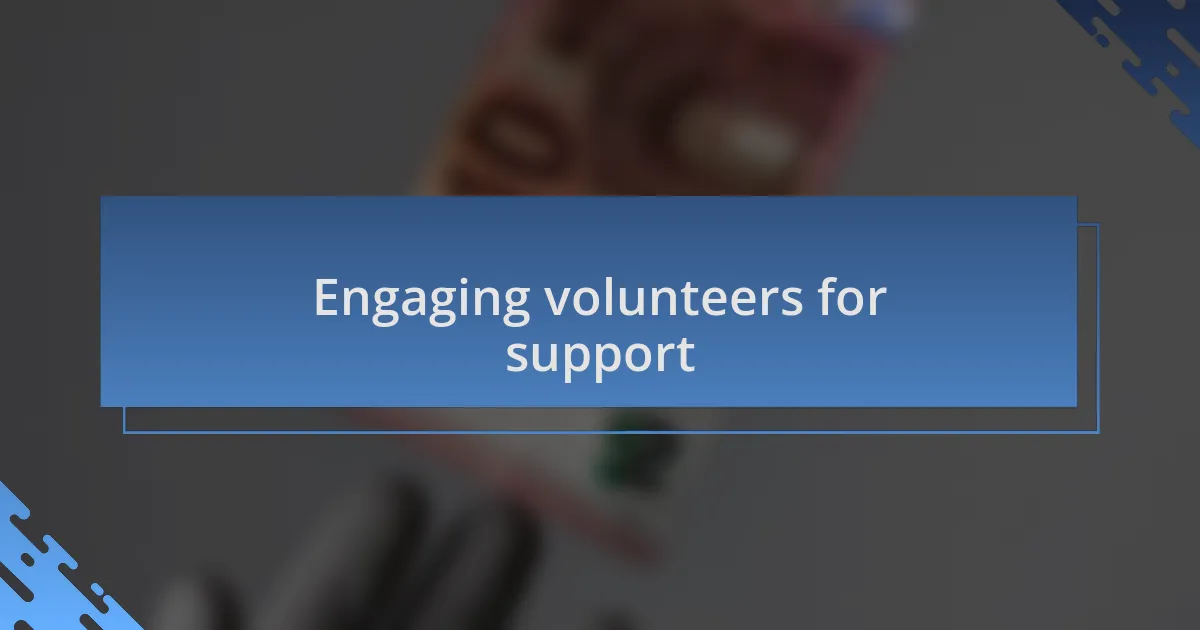
Engaging volunteers for support
Engaging volunteers is like planting seeds in fertile soil. I remember organizing a small gathering to introduce potential volunteers to our mission. The enthusiasm in the room was palpable. Sharing personal stories of the individuals we’ve helped created an emotional connection that inspired many attendees to get involved. Have you ever noticed how powerful it is when people hear firsthand accounts of impact? It’s that spark that often drives them to take action.
Finding the right volunteers is crucial to sustaining support. One time, I reached out to a local university’s service learning coordinator. I proposed a collaboration that would allow students to earn credit while volunteering with us. This idea not only brought in energetic individuals but also introduced fresh perspectives to our initiatives. It made me realize the value of tapping into community resources that align with our goals. How can we harness these connections to fuel our efforts even more?
Encouraging ongoing engagement is equally important. I’ve created a monthly newsletter to keep our volunteers informed about our activities and success stories. When volunteers feel connected to our mission, they’re more likely to stay involved and invite others to join. Isn’t it amazing how a simple communication can foster loyalty and a sense of belonging? Each time I receive a heartfelt response from a volunteer reflecting on their experience, it reassures me that we’re building something meaningful together.
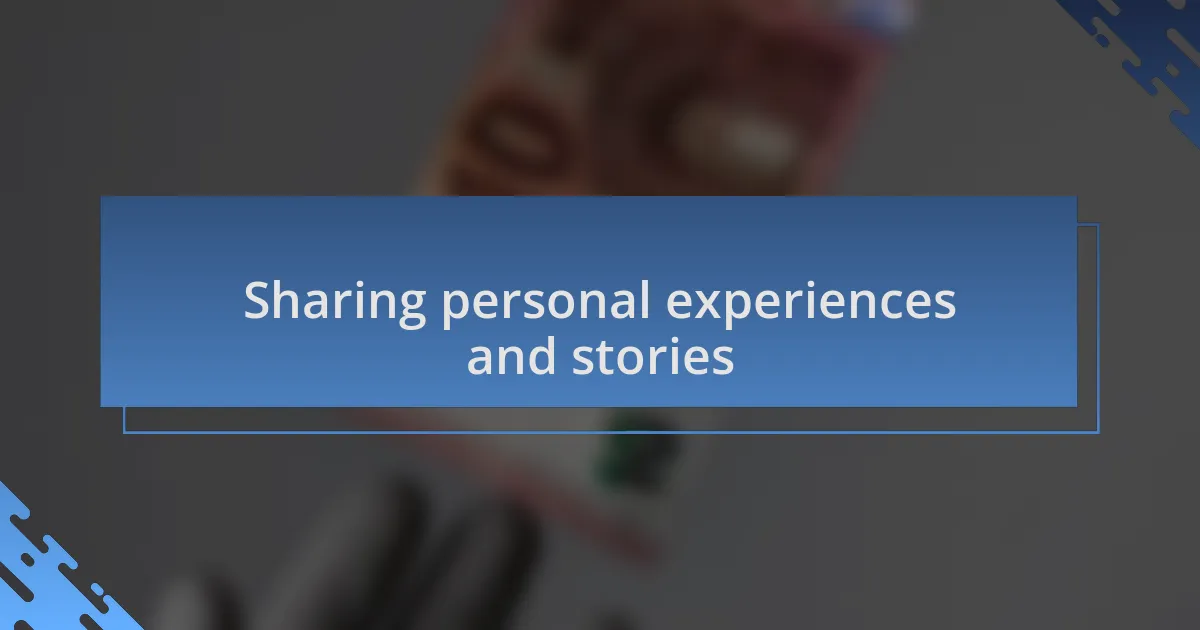
Sharing personal experiences and stories
When I began reaching out to others about my own journey with homelessness, I found that sharing my story was both cathartic and empowering. I vividly remember one evening, sitting in a community center, recounting my experiences to a small group of people. I could see their eyes widen with empathy and understanding, and in that moment, I understood the profound impact vulnerability can have in building connections. Have you ever felt your heart pull when you relate to someone’s struggle?
One of the most memorable moments came when a former client shared her experience with our network at a local event. Her candid reflection on the challenges she faced and how our support had transformed her life moved many to tears. It wasn’t just her words, but the authenticity behind them that created an electric atmosphere. Listening to stories like hers reminds me why we do what we do. Don’t you find that when personal stories are shared, they not only inform but also inspire?
I also launched a blog where individuals are encouraged to share their experiences anonymously. The stories that pour in are often raw and real, and each one adds a unique layer to our understanding of homelessness. Recently, a young woman wrote about her struggles with mental health and how finding community helped her navigate tough times. Each narrative serves as a powerful reminder that we are not alone in our journeys. Isn’t it incredible how these stories can foster empathy and drive change in our community?
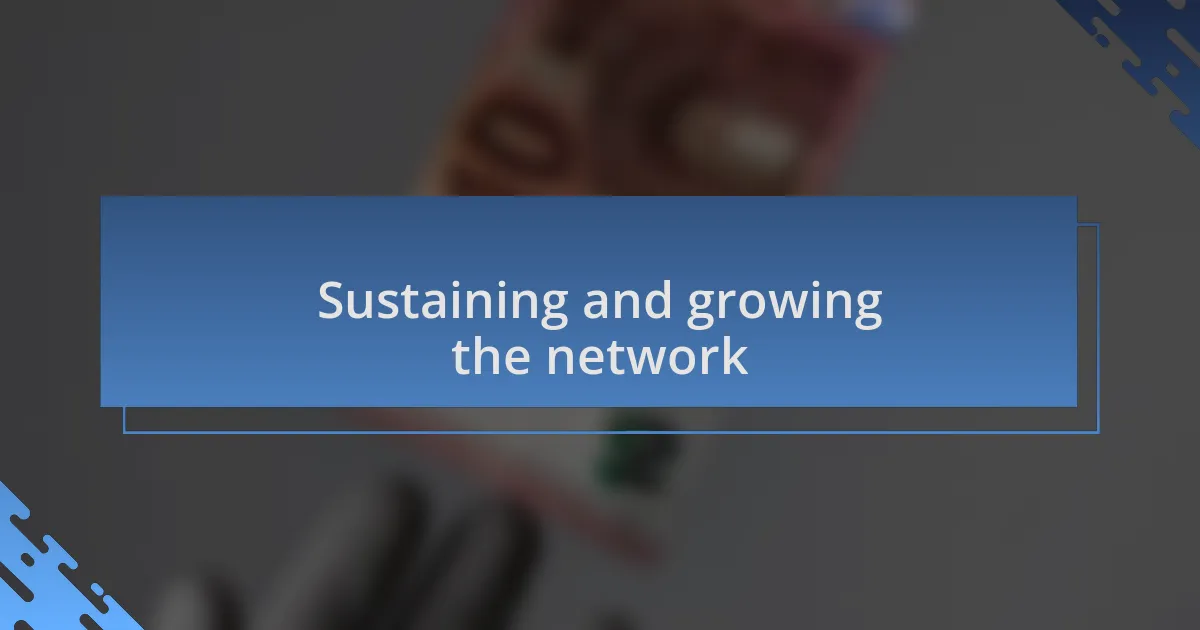
Sustaining and growing the network
To sustain and grow our local support network, I believe it’s essential to nurture the connections we’ve made. For instance, after a successful fundraising event, I organized follow-up meetings to thank volunteers and share the outcomes of their efforts. This practice not only shows appreciation but also helps reinforce our shared mission. Have you ever noticed how a simple thank you can deepen relationships?
I also actively seek feedback from those within the network. I remember a time when I initiated a survey after a community workshop. The responses revealed a desire for more skill-building sessions, allowing us to adapt to the real needs of our members. This responsiveness fosters trust and encourages more people to join, knowing their voices matter. Isn’t it fascinating how engagement can unlock new opportunities for growth?
Another vital strategy has been collaborating with other organizations. I’ve reached out to local shelters to share resources and ideas, creating a synergetic effect that benefits all involved. This collaboration not only broadens our reach but also pools our experiences and strengths. Reflecting on how collective efforts amplify our impact, I can’t help but wonder: what other partnerships could we explore to further enrich our community?